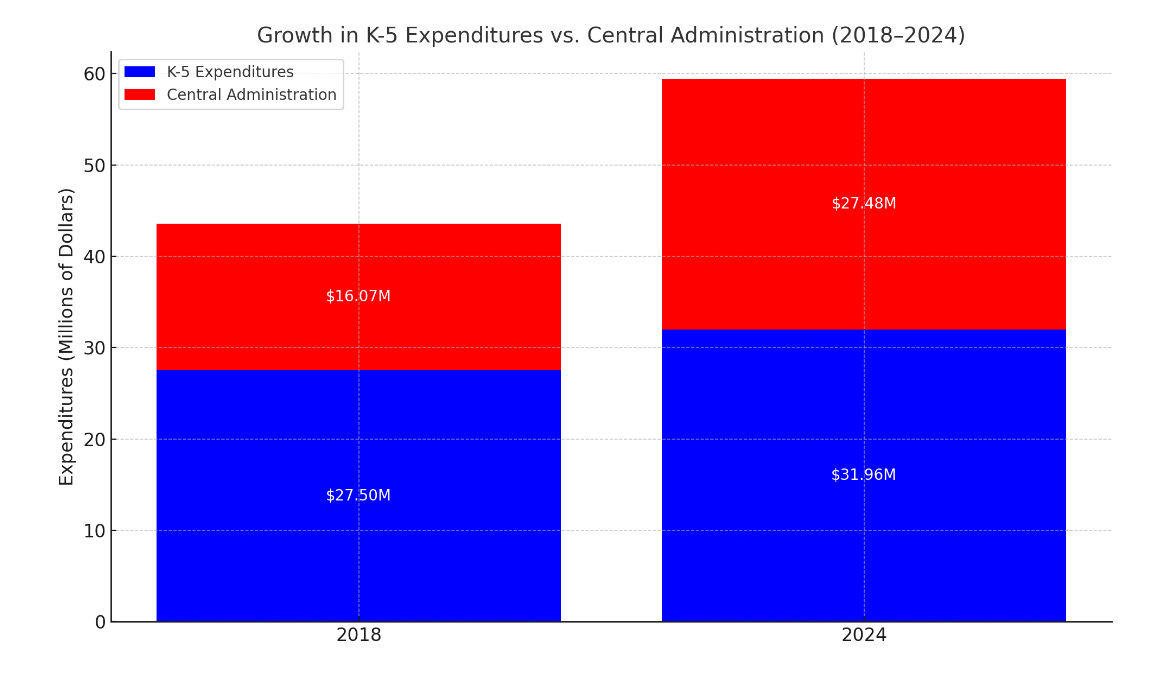Tonight the school district will receive data and scenarios from the district. They will be asked to weigh if any or all of our three small schools should be closed or consolidated. The school board meeting is at Riverside High School at 5pm. We need you to show up to show you care.
When the district gives the school board scenarios will they receive this data?
• Central administration expenses have skyrocketed by 71% since 2018, despite declining enrollment1.2
• Some departments’ budgets have grown by as much as 130%, while elementary school budgets increased by only 16.23%.
• The district projects a $10 million surplus in the general fund for 2024, yet school closures are being considered.
• COVID relief funds were minimal and are not the reason for our current financial challenges—property tax revenues have largely supported our budget.
• If unnecessary administrative growth were reined in, over $6.7million could be saved without cutting from classrooms.
Let’s Break it Down
Rising Costs with Fewer Students
Enrollment has declined from 9,940 in 2018 to 9,049 in 2023.
Despite this, central district administration costs have exploded, growing by $11.4 million (71%) since 2018.
Inflation vs. Overgrowth
Many administrative departments are growing far beyond inflation-adjusted costs:
Example: “Improvement of Instruction Services” grew by 166% in total expenses.
Another department, “Special Services Director,” has added more administrators despite declining enrollment, leading to a 130% increase in costs.
Comparing Growth Rates
K-5 school budgets increased by just 16.23%.
Meanwhile, administrative departments have increased by 71% on average.
A large contributor to this is administrative salaries which have risen by 55.32% on average.
Surplus Funds Are Available
For 2024, the district is projecting over $10 million left over in the general fund.
While a new recommendation suggests maintaining a 16% contingency fund, historically, the district has never reached that percentage. It’s a noble goal but not an emergency.3
COVID Funds Were Not a Crutch
The district received approximately $6 million in COVID relief over two years—a small portion of the budget.
Our reliance on property tax revenue means financial support has remained steady even as federal relief ended.4
The Real Savings Lie in Administration
If administrative costs were kept within inflation-adjusted levels, we could save $6.7 million.
This means school closures—which save an estimated $500,000 per school—are not the only or best option.
Why This Matters
Closing schools targets the most efficient part of the system. Our elementary schools operate at high efficiency despite already facing the deepest budget cuts. They also serve the area with the most projected enrollment growth over the next decade.5
Meanwhile, unchecked administrative spending has ballooned, pulling resources away from classrooms. If we close schools or cut teachers without addressing the problem of Administrative spending, admin will continue to grow and eat up more and more of the budget ?
What We Can Do
1. Demand Transparency:
• Ask why central administrative costs have grown so much more than inflation and enrollment would justify.
• Insist on an independent analysis of the budget.
2. Advocate for Students:
• Prioritize cutting administrative waste instead of closing schools.
3. Share the Facts:
• Let others in the community know that closures are not the only—or best—solution.
This issue affects us all, whether you’re a parent, teacher, or community member. Let’s work together to ensure that our district’s budget truly prioritizes students. School closures should be the last resort, not the first option.
Showing my work. Here is the full calculation:
https://www.wlwv.k12.or.us/cms/lib/OR01001812/Centricity/Domain/44/24-25%20Adopted%20Budget.pdf
https://www.wlwv.k12.or.us/cms/lib/OR01001812/Centricity/Domain/44/Budgets/18_19_ADOPTED_DOCUMENT_FINAL.pdf
https://www.wlwv.k12.or.us/Page/254
https://www.oregon.gov/ode/schools-and-districts/grants/Pages/ESSER-Transparency.aspx
https://www.wlwv.k12.or.us/cms/lib/OR01001812/Centricity/Domain/100/WLWV%202024-25%20to%202033-34%20Enrollment%20Forecasts%20Report%20Memo.pdf











